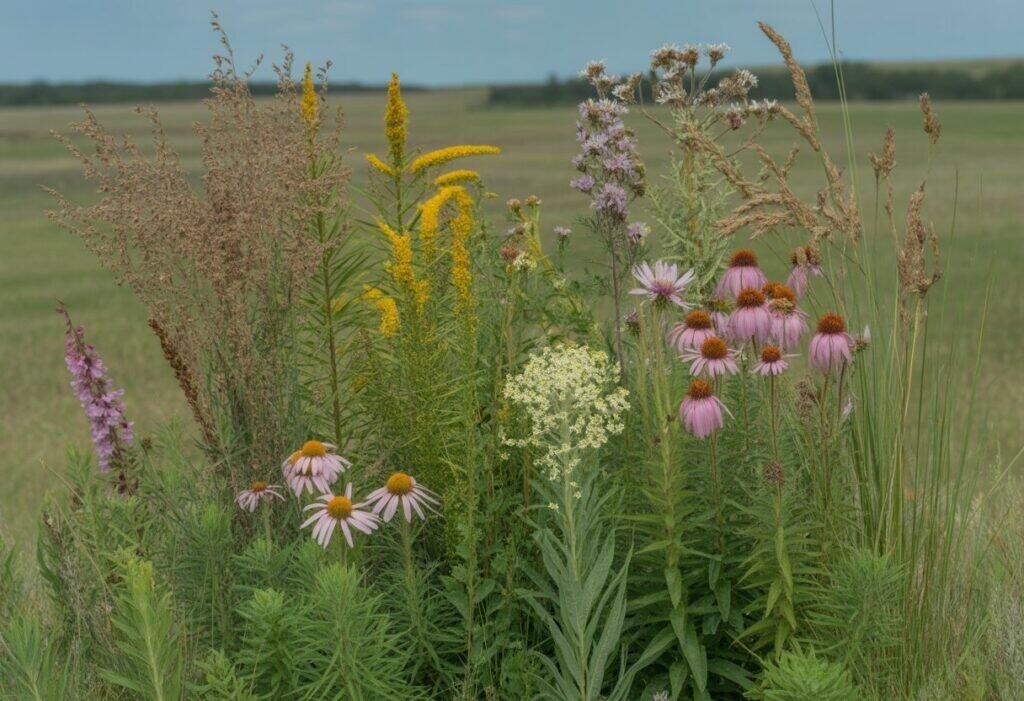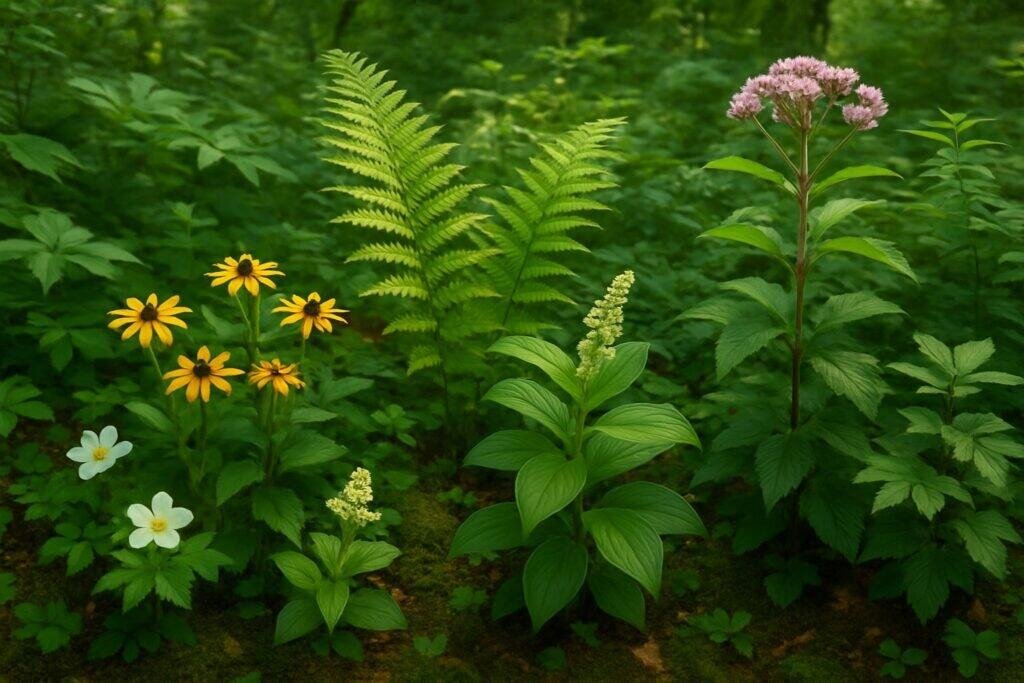Nebraska is home to a remarkable diversity of native plants adapted to its unique climate and soil conditions. These plants have evolved over thousands of years to thrive in the state’s varying landscapes, from the eastern woodlands to the western plains.
Incorporating Nebraska’s native plants into your garden creates a beautiful, low-maintenance landscape. These plants also support local ecosystems and wildlife.
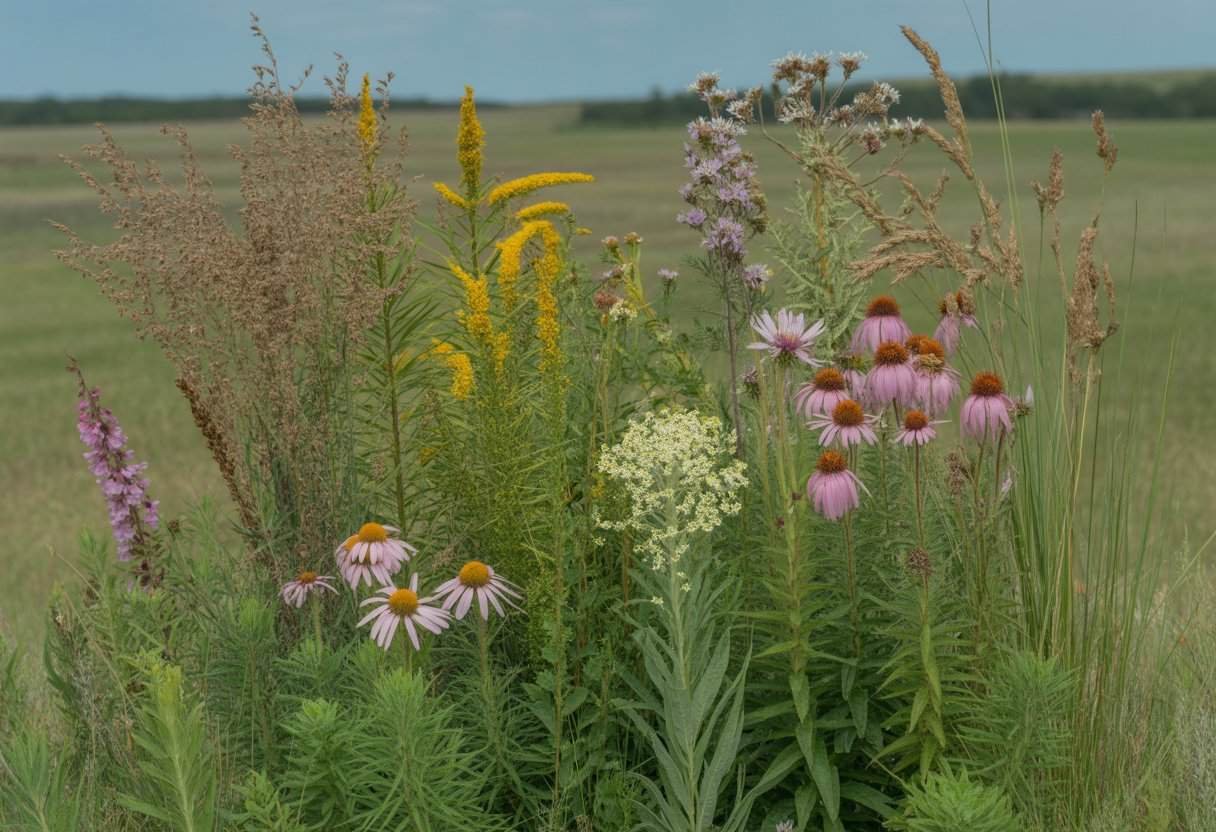
Native plants need less water, fertilizer, and care than non-native species once they become established. They provide essential habitat for birds, butterflies, and beneficial insects that co-evolved with these plants.
Many Nebraska natives also offer stunning seasonal displays. You can enjoy vibrant purple coneflowers and black-eyed Susans in summer and golden prairie grasses in fall.
Key Takeaways
- Nebraska native plants are adapted to local conditions, requiring less water and maintenance than non-native species.
- Native plants support local wildlife including pollinators, birds, and beneficial insects essential to our ecosystem.
- Different regions of Nebraska support various native plant communities, offering options for every landscape from woodland gardens to prairie restorations.
Understanding Nebraska’s Native Plants
Nebraska’s landscape features a rich variety of native plants that have thrived in the region for thousands of years. These plants developed special traits to survive Nebraska’s unique climate and soil conditions.
Defining Native Species
Native plants are species that occurred naturally in Nebraska before European settlement. These plants evolved in the Great Plains region over thousands of years.
They include grasses like big bluestem and little bluestem, which once dominated the prairies. Native wildflowers such as purple coneflower, black-eyed Susan, and butterfly milkweed add color to Nebraska’s landscape.
Trees and shrubs like bur oak, eastern redbud, and wild plum are also important native species. These plants provide essential habitat for Nebraska wildlife.
Birds, insects, and mammals depend on native plants for food and shelter. Native species vary across Nebraska’s regions.
Western Nebraska features more drought-resistant plants. Eastern areas support species that can handle higher rainfall.
Native Plant Adaptations
Nebraska native plants have developed remarkable adaptations to survive harsh conditions. Many prairie species grow deep root systems—sometimes extending 15 feet underground—to access water during droughts.
These root networks help plants survive wildfires, a natural part of the Great Plains ecosystem. After fire sweeps across the surface, plants regrow from their protected roots.
Native grasses and wildflowers can withstand Nebraska’s temperature extremes. They survive winter temperatures below zero and summer heat over 100°F.
Some adaptations include:
- Waxy leaf coatings that reduce water loss
- Hairy stems and leaves that trap moisture
- Dormancy periods during extreme conditions
- Wind resistance for plants in open prairies
These adaptations make native plants more resilient than non-native species in Nebraska’s climate.
Native Plants vs. Non-Native Plants
Native plants offer significant advantages over non-native species in Nebraska landscapes. They typically need less water, fertilizer, and maintenance once established.
Benefits of native plants:
- Require minimal irrigation after establishment
- Resist local pests and diseases naturally
- Provide appropriate food for local wildlife
- Prevent soil erosion with deep root systems
- Maintain genetic diversity in the ecosystem
Non-native plants often struggle with Nebraska’s climate extremes. They may need extra water, fertilizer, or pest control to survive.
Some non-native species become invasive, crowding out native plants. Leafy spurge and musk thistle damage Nebraska’s ecosystems and agricultural lands.
Using native plants in gardens and landscapes helps preserve Nebraska’s natural heritage. They connect modern landscapes to the historic Great Plains ecosystem.
Major Groups of Nebraska Native Plants
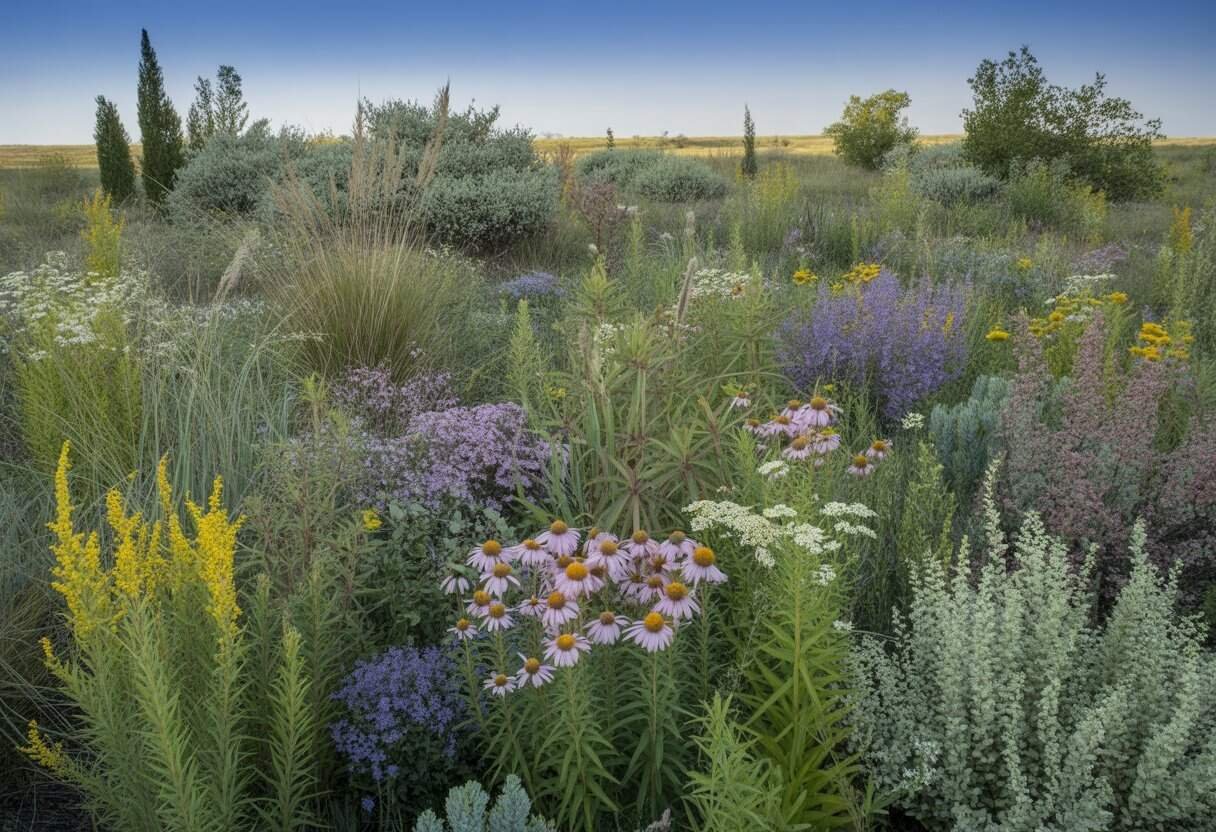
Nebraska’s landscape includes diverse plant communities adapted to the state’s varying climate and soil conditions. Native plants fall into several categories, each playing a vital role in the state’s ecosystems.
Wildflowers and Forbs
Nebraska boasts an impressive variety of native wildflowers. The state flower, goldenrod, brightens prairies with its yellow blooms in late summer.
Purple coneflower, with its spiky center, serves as both a beautiful wildflower and a medicinal plant used by Native Americans. Black-eyed Susans thrive in sunny areas, adding vibrant gold to meadows.
Prairie blazing star produces tall purple spikes that attract pollinators. Butterfly milkweed, with its bright orange flowers, provides essential habitat for monarch butterflies.
Common prairie wildflowers include:
- Wild bergamot (bee balm)
- Prairie phlox
- Pasque flower (early spring bloomer)
- Spider milkweed
- Canada anemone
Many of these wildflowers have deep root systems and drought tolerance mechanisms.
Grasses and Sedges
Native grasses form the backbone of Nebraska’s prairie ecosystems. Big bluestem, often called “turkey foot,” can reach heights of 6-8 feet and once dominated the eastern tallgrass prairie.
Little bluestem displays blue-green stems in summer that turn rusty-red in fall. This medium-height grass thrives in various conditions across the state.
Switchgrass, with its airy seed heads, provides excellent wildlife habitat. Indian grass shows off golden-bronze seed heads in late summer.
Its blue-green foliage turns copper-orange in autumn.
Key Nebraska Native Grasses:
| Grass Type | Height | Habitat |
|---|---|---|
| Big bluestem | 6-8 ft | Tallgrass prairie |
| Little bluestem | 2-4 ft | Mixed prairie |
| Switchgrass | 3-5 ft | Various conditions |
| Indian grass | 4-7 ft | Tallgrass prairie |
| Buffalo grass | 4-6 inches | Shortgrass prairie |
Sedges, grass-like plants often found in wetlands, include fox sedge and prairie sedge species.
Shrubs and Small Trees
Nebraska’s native shrubs provide important wildlife habitat and food sources. Wild plum forms dense thickets with fragrant white spring flowers followed by edible fruits.
These thickets offer shelter for birds and small mammals. Chokecherry produces clusters of white flowers and dark purple berries used in traditional jams and syrups.
American hazelnut, a woodland shrub, produces edible nuts enjoyed by wildlife and humans. Leadplant, a prairie shrub with feathery leaves and purple flower spikes, indicates healthy prairie conditions.
Its deep roots can extend over 15 feet below ground.
Other important native shrubs include:
- Smooth sumac (brilliant red fall color)
- Fragrant sumac (drought-tolerant)
- Wild rose (state flower of Iowa)
- Buffalo berry (nitrogen-fixing)
Native shrubs need less maintenance than introduced species once established in appropriate sites.
Ferns and Uncommon Native Flora
While Nebraska isn’t known for abundant ferns, several native species persist in shaded, moist habitats. Lady fern thrives in the state’s eastern forests, especially along streams and in protected ravines.
Sensitive fern, named for its quick response to frost, grows in wet meadows and woodland edges. The hardy Christmas fern maintains green fronds throughout winter in protected locations.
Nebraska hosts several uncommon plant communities. Remnant oak savannas feature scattered bur oaks with prairie understories.
These rare ecosystems support specialized plants like cream wild indigo and bottle gentian. Sand prairies in the Sandhills region contain unique species adapted to shifting soils.
- Blowout penstemon (federally endangered)
- Sand cherry
- Yucca (with specialized moth pollinators)
Alkaline wetlands support rare plants like the salt marsh aster and seaside heliotrope. These species are typically found in coastal environments.
Notable Native Flowers of Nebraska
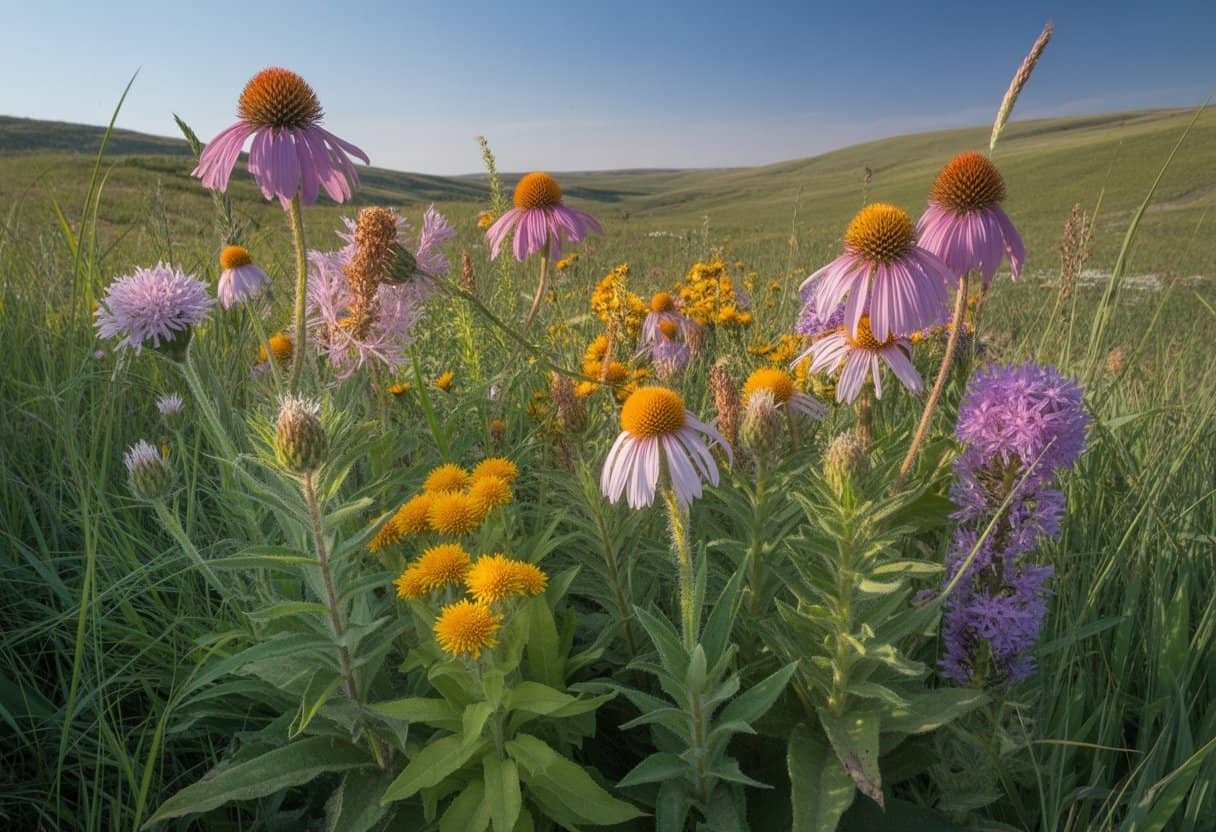
Nebraska’s diverse landscapes support a variety of beautiful native flowers that thrive in the state’s unique climate and soil conditions. These plants provide essential habitat for pollinators and add vibrant colors to gardens and natural areas.
Butterfly Milkweed (Asclepias tuberosa)
Butterfly milkweed displays bright orange flowers that bloom from June to August. Unlike other milkweeds, it doesn’t contain the milky sap that gives the family its name.
This drought-tolerant plant grows about 1-2 feet tall and prefers well-drained soils in full sun. Butterfly milkweed serves as a crucial host plant for monarch butterfly caterpillars and attracts many other pollinators.
The plant’s deep taproot helps it survive Nebraska’s hot summers with little water. Native Americans historically used butterfly milkweed for medicinal purposes.
In home gardens, butterfly milkweed works well in prairie-style plantings and butterfly gardens. The plant is deer-resistant and needs little maintenance once established.
Purple Coneflower (Echinacea purpurea)
Purple coneflower stands as one of Nebraska’s most recognizable native flowers. Its purple-pink petals surround a raised copper-colored center cone.
This hardy perennial blooms from June through August and grows 2-4 feet tall. Purple coneflower tolerates drought, poor soil, and neglect.
Wildlife Benefits:
- Attracts butterflies, bees, and hummingbirds
- Provides food for goldfinches and other birds when seed heads form
- Supports native pollinators throughout summer
The pale purple coneflower (Echinacea pallida) is a related native species with narrower petals and a delicate appearance. Both varieties have been used in traditional medicine.
In landscaping, purple coneflower pairs beautifully with native grasses and other prairie plants.
Blazing Star and Gay Feather
Blazing star (Liatris) plants, also called gay feather, produce stunning purple spikes that bloom from the top down. These vertical accents can reach 3-5 feet tall in ideal conditions.
Several Liatris species are native to Nebraska, including meadow blazing star and dotted blazing star. These drought-tolerant plants prefer full sun and well-drained soil.
Blazing star’s nectar-rich flowers attract many butterflies, especially monarchs and swallowtails. The plant’s unique blooming pattern provides visual interest for weeks.
Growing Tips:
- Plant in spring or fall
- Space 12-15 inches apart
- Divide clumps every 3-4 years to maintain vigor
Blazing star makes excellent cut flowers and adds architectural interest to gardens. The plant’s seed heads persist into winter and add texture to the landscape.
Black-Eyed Susan and Aromatic Aster
Black-eyed Susan (Rudbeckia) brings cheerful yellow flowers with dark centers to Nebraska gardens from June through September. This short-lived perennial self-seeds readily, creating long-lasting colonies.
Growing 1-3 feet tall, black-eyed Susan thrives in average soil and full to partial sun. Its daisy-like flowers attract beneficial insects to the garden.
Aromatic aster (Symphyotrichum oblongifolium) provides important late-season color with lavender-blue flowers that bloom from September until frost. The plant’s foliage has a pleasant scent when crushed.
This low-growing aster reaches about 1-2 feet tall and spreads to form attractive mounds. It tolerates drought and poor soils, making it suitable for tough garden locations.
Both plants support pollinators when many other flowers have finished blooming. They complement each other in native plant gardens, with black-eyed Susan providing summer color and aromatic aster extending the season into fall.
Significant Native Trees and Grasses
Nebraska’s landscape is defined by its remarkable native trees and grasses that have evolved to thrive in the state’s unique climate. These plants provide essential habitat for wildlife and represent the natural heritage of the Great Plains.
State Tree: Cottonwood
The Eastern Cottonwood (Populus deltoides) became Nebraska’s official state tree in 1972. This tree can grow up to 100 feet tall with a trunk diameter of 6 feet.
Cottonwoods thrive along rivers and streams. Their extensive root systems help prevent erosion.
The name “cottonwood” comes from its seeds. Cotton-like fibers surround the seeds and help them travel on wind and water.
Pioneers used these trees as landmarks and shelter. Cottonwoods grow quickly, sometimes adding 3-5 feet per year in good conditions.
Their heart-shaped leaves create a rustling sound in the breeze. The trees provide important habitat for birds, including bald eagles that often nest in their sturdy branches.
Iconic Grasses: Little Bluestem and Indian Grass
Little Bluestem (Schizachyrium scoparium) is one of Nebraska’s most recognizable native grasses. This bunch grass grows 2-4 feet tall with a blue-green color that turns copper-red in fall.
Its adaptability to various soil types makes it widespread across Nebraska’s prairies. Indian Grass (Sorghastrum nutans) reaches heights of 3-7 feet with golden seedheads that catch the sunlight.
Indian grass is a dominant component of Nebraska’s tallgrass prairies. It provides excellent forage for wildlife and livestock.
Both grasses develop deep root systems that may extend 8-12 feet into the soil. This adaptation helps them survive drought conditions and stabilize prairie soils.
Their seed heads provide food for birds throughout winter. Their dense growth creates nesting habitat for ground birds.
Perennial Grasses for Prairies
Nebraska’s prairie ecosystems rely on a diverse mix of perennial grasses. Big Bluestem, often called “turkey foot” due to its three-part seedhead, can reach heights of 6-8 feet.
Switchgrass thrives in various conditions and grows in clumps 3-5 feet tall. Its extensive root system helps prevent soil erosion and improves water quality.
Prairie dropseed forms dense tufts reaching 2-3 feet tall with arching leaves. It produces seeds with a unique aroma that some describe as resembling fresh popcorn.
Their root systems, which can equal their above-ground height, help build rich soil and capture carbon. Many Nebraska conservation efforts focus on restoring these native grasses to rebuild healthy prairie ecosystems.
Native Plants for Pollinators and Wildlife
Nebraska’s native plants support local wildlife and pollinators. These plants have evolved alongside native insects and animals, creating relationships that help both thrive.
Plants for Butterflies and Hummingbirds
Butterflies are attracted to bright, colorful flowers with flat landing surfaces. Purple coneflower (Echinacea purpurea) serves as both a nectar source for adults and host plant for butterfly larvae.
Butterfly milkweed (Asclepias tuberosa) is essential for monarch butterflies, providing food for their caterpillars. Hummingbirds prefer tubular flowers with bright colors, especially red.
Cardinal flower (Lobelia cardinalis) with its vibrant red blooms is a hummingbird favorite in moist areas. Wild bergamot (Monarda fistulosa) attracts both hummingbirds and butterflies with its lavender flowers.
Other excellent butterfly and hummingbird plants include:
- New England aster (Symphyotrichum novae-angliae)
- Wild columbine (Aquilegia canadensis)
- Rough blazing star (Liatris aspera)
Nectar and Seedheads for Wildlife
Native plants provide food for wildlife throughout the seasons. Spring flowers like wild plum (Prunus americana) offer early nectar for emerging pollinators.
Summer bloomers such as compass plant (Silphium laciniatum) provide abundant nectar during peak growing season. In fall and winter, seedheads become vital food sources.
Sunflowers (Helianthus spp.) produce seeds eagerly consumed by birds. Little bluestem (Schizachyrium scoparium) and other native grasses offer both seeds and winter shelter.
Elderberry (Sambucus canadensis) produces berries that feed over 40 bird species. Prairie coneflower (Ratibida columnifera) seedheads persist through winter, feeding goldfinches and other small birds.
Pollinator Gardens and Biodiversity
Creating a pollinator garden increases biodiversity in your landscape. Plant in groups of at least three of each species to help pollinators find flowers.
Include plants with different bloom times to provide food throughout the growing season. Native bees need bare soil patches for nesting, while butterflies require puddles for minerals.
Add a shallow water source with landing spots for insects to drink safely. Choose plants with diverse shapes and sizes:
| Plant Type | Example | Benefits |
|---|---|---|
| Ground cover | Wild strawberry | Provides shelter for small insects |
| Mid-height | Prairie phlox | Offers nectar for various pollinators |
| Tall | Joe-Pye weed | Creates wildlife habitat structure |
Including native grasses like sideoats grama (Bouteloua curtipendula) alongside flowering plants creates a more complete ecosystem. This supports diverse wildlife in your garden.
Regional Variations in Nebraska Native Plants
Nebraska’s diverse geography creates distinct plant communities from east to west. The state’s 400-mile span features changes in rainfall, soil types, and elevation.
Eastern Nebraska Native Flora
Eastern Nebraska receives more rainfall, typically 25-35 inches annually. This supports a rich diversity of woodland and prairie plants.
The Missouri River valley hosts oak-hickory forests with species like woodland sedge and Virginia bluebells. Tallgrass prairie dominates much of eastern Nebraska with big bluestem, which can reach 6-8 feet.
Indian grass and switchgrass thrive alongside colorful wildflowers such as purple coneflower, compass plant, and prairie blazing star. Wetland areas near the Platte and Missouri Rivers feature cordgrass, sedges, and cattails.
These riparian zones provide crucial habitat for wildlife and help filter water before it enters streams and rivers.
Western Nebraska Species
Western Nebraska’s arid climate, with only 15-20 inches of annual rainfall, creates different plant communities. Shortgrass prairie dominates this region with drought-resistant species like blue grama and buffalo grass.
These grasses rarely grow taller than 12 inches. The Nebraska Sandhills, covering nearly 20,000 square miles, support specialized plants adapted to sandy soils.
Sand bluestem, prairie sandreed, and yucca have extensive root systems that stabilize dunes and access deep moisture. Pine Ridge in the northwest features ponderosa pine forests more typical of Rocky Mountain ecosystems.
These woodlands include understory plants like kinnikinnick and skunkbush sumac that tolerate dry, rocky conditions.
Conservation Across Nebraska
Less than 2% of Nebraska’s original tallgrass prairie remains intact. Preservation efforts are critical for remaining parcels.
Several organizations protect Nebraska’s plant diversity through seed collection, habitat restoration, and public education. The Nebraska Statewide Arboretum maintains regional plant collections that showcase native species for different areas of the state.
Researchers monitor how native plant communities respond to changes in rainfall and growing seasons. Some species may need additional protection as climate patterns shift.
Landowners increasingly recognize the value of native plants for soil health, wildlife habitat, and drought resistance. Many now incorporate native species into agriculture through buffer strips and conservation plantings.
Designing Low Maintenance Landscapes with Native Plants
Nebraska native plants offer excellent options for beautiful, low-upkeep landscapes. These plants have adapted to local conditions over thousands of years, making them naturally suited to thrive with less intervention.
Perennials for Year-Round Interest
Native perennials provide visual appeal throughout the seasons with minimal effort. Prairie blazing star adds vibrant purple spikes in summer, while butterfly milkweed offers bright orange blooms.
Black-eyed Susans deliver yellow flowers from mid-summer into fall. For winter interest, consider little bluestem grass.
Its blue-green summer foliage turns coppery-red in fall and remains standing through winter snow. These plants establish deep root systems that require less watering once established.
- Coneflowers: Purple blooms in summer, seed heads in winter
- Wild bergamot: Lavender flowers that attract bees
- Prairie smoke: Unusual feathery seed heads
- Goldenrod: Yellow fall color when other plants fade
Planning for Less Maintenance
Group plants with similar water needs together to prevent overwatering or underwatering. This practice, called hydrozoning, saves time and resources.
Native plants typically need little or no fertilizer. Their natural adaptations to Nebraska soils eliminate the need for chemical amendments.
Consider these low-maintenance design principles:
- Create dense plantings to suppress weeds
- Apply 2-3 inches of mulch to reduce weeds and retain moisture
- Select plants for your specific light conditions
- Space plants for mature size to reduce future pruning
A simple irrigation system with a timer can further reduce maintenance. This ensures plants receive adequate water during establishment.
Supporting Local Ecosystems
Native plant landscapes foster thriving local ecosystems. Nebraska’s native bees, butterflies, and birds depend on these plants for food and habitat.
A landscape with diverse native species supports more wildlife than non-native alternatives. Bird-friendly native shrubs like elderberry and chokecherry provide food and nesting sites.
The berries feed wildlife while adding visual interest to your landscape. Native plants also improve soil health.
Their extensive root systems prevent erosion and increase organic matter. Some, like sideoats grama grass, can extend roots up to 5 feet deep.
Native plantings benefit water quality. Their deep roots filter pollutants and allow rainwater to soak into the ground instead of running off.
Scientific Research and Resources on Nebraska Native Plants
Nebraska’s native plants have attracted research from botanists, ecologists, and conservation scientists. These studies provide valuable insights for gardeners, conservationists, and landowners.
Botanical Studies and Ongoing Research
The University of Nebraska-Lincoln researches native plant species through its Department of Agronomy and Horticulture. Their Prairie Plants of Nebraska project has documented over 200 species native to the state’s grasslands.
The Nebraska Natural Heritage Program tracks rare plant populations and habitats. Their database includes detailed information on the distribution and status of threatened plant species.
Several studies focus on how native plants support pollinators. The Xerces Society, in partnership with Nebraska researchers, has identified key native plant species for bees and butterflies.
Climate change studies examine how warming temperatures affect native plant communities. This research helps predict which species may need conservation in coming decades.
Connecting with Local Experts and Organizations
The Nebraska Native Plant Society offers workshops, field trips, and educational resources for plant enthusiasts. Their annual wildflower weekend connects citizens with botanical experts.
Nebraska Extension offices in each county provide soil testing services and plant selection advice. The Master Gardener program trains volunteers who can help with native plant questions.
The Nebraska Statewide Arboretum maintains demonstration gardens featuring native plants. These gardens show how different species perform in various settings.
Local nurseries specializing in native plants often employ knowledgeable staff. These businesses host educational events and can recommend plants suited to specific growing conditions.
Frequently Asked Questions
Nebraska native plants offer many benefits for home gardeners and wildlife. These plants have adapted to local conditions over thousands of years, making them resilient choices for landscaping and conservation.
What are some recommended Nebraska native plants for home landscaping?
Purple coneflower thrives in Nebraska gardens with its purple petals and orange center. This drought-resistant perennial blooms from June to August.
Prairie dropseed creates mounds of fine-textured foliage that turns golden in fall. It reaches about 2-3 feet tall and works well as a border plant.
Butterfly milkweed produces vibrant orange flowers that attract monarchs and other pollinators. This native plant grows well in full sun and handles poor soil conditions.
Wild bergamot (bee balm) features lavender flowers that attract bees and butterflies. It grows 2-4 feet tall and spreads gradually through rhizomes.
How can I identify Nebraska native plants in the wild?
Field guides specific to the Great Plains region provide descriptions and images of native plants. The Nebraska Statewide Arboretum website offers plant identification resources.
Plant identification apps like iNaturalist help identify wild plants using smartphone photos. These apps compare images against databases and suggest possible matches.
Key identification features include leaf arrangement, flower structure, and growth habit. Native plant workshops offered by conservation organizations teach practical identification skills.
Which native plants are best suited for the Omaha, Nebraska climate?
Bur oak trees thrive in Omaha’s climate and can live for centuries. These trees provide shade and wildlife habitat while handling urban conditions.
Little bluestem grass withstands Omaha’s temperature extremes. Its blue-green summer foliage turns reddish-bronze in fall, and it grows in clumps reaching 2-3 feet tall.
Black-eyed Susan tolerates Omaha’s hot summers and cold winters. Its bright yellow flowers bloom from June through September and add color to gardens.
Prairie blazing star produces tall purple flower spikes that attract butterflies. This drought-tolerant perennial blooms in late summer.
What are the most common native animals that interact with Nebraska’s flora?
White-tailed deer browse on native shrubs and wildflowers throughout Nebraska. Their feeding habits shape plant communities by controlling certain species’ growth.
Eastern cottontail rabbits consume grasses and herbaceous plants. They create habitat patterns by feeding on preferred plant species.
Honeybees and native bees pollinate many flowering plants. Different bee species visit specific native flowers based on tongue length and flower structure.
Monarch butterflies depend on milkweed species for reproduction. Their caterpillars feed only on milkweed leaves, making these plants essential for monarchs.
Where can one purchase Nebraska-native plants for gardening?
The Nebraska Statewide Arboretum hosts seasonal plant sales featuring native species. Their spring and fall events offer plants adapted to local conditions.
Local nurseries like Great Plains Nursery and Stock Seed Farms specialize in native plants. These businesses provide plants grown from local seed sources.
Conservation district plant sales occur annually in many Nebraska counties. These sales offer native trees, shrubs, and perennials at reasonable prices.
Online native plant retailers ship throughout Nebraska. Prairie Moon Nursery and Prairie Nursery offer extensive selections of Great Plains native species.
Which native plants in Nebraska are known to attract and sustain pollinators?
Goldenrod supports over 100 pollinator species with its late-season nectar. It does not cause hay fever and provides crucial fall food for bees.
Wild indigo attracts specialized native bees with its blue-purple flowers. This plant also serves as a host for several butterfly species.
Pasque flower blooms in early spring when few other nectar sources are available. Its early flowers provide essential food for emerging queen bumblebees.
Sunflowers support diverse pollinators including bees, butterflies, and beetles. Their large flower heads offer abundant pollen and nectar, and their seeds later feed birds.

